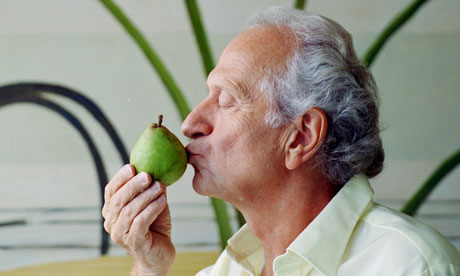
My first encounter with Michel Roux followed a lunch with my mother at Le Gamin, a Roux brasserie in Old Bailey, London, about 30 years ago. The outing was an inspection for the Egon Ronay Guide, and after a terrific meal – including fresh, hot foie gras, so rare to find in those days – I paid and took myself off to secure details for the Guide from the manager. En route I caught sight of chef Roux striding across the tiled floor to the exit.
I quickly decided there could be no better person to talk to; a real Roux, after all. His rebuff, however, was swift and intense: the pale blue piercing eyes; the impatience as I timidly approached him halfway up the steep staircase; his indifference to my shaky question as to whether we may "chat for a few moments?" He brushed me off in the vague direction of a besuited maitre d'. Sweating slightly from the ordeal, I sat down with this lesser mortal. "Do not worry," the maitre d' said. "He had to come in at the last minute to do the cuisine. So, fire away."
Many years later, when I was working with Michel as a judge for the Roux Scholarship, I retold this incident. He put his arm around my shoulder and said: "Was I really so 'orrible to you?" Oh yes, I replied, you were terrifying! 'Good!' he said. And we laughed.
My main occupation at that time was as a cook in a grand private house in Chelsea. As a young man, Michel also did this, but much more grandly: for the Rothschilds in Paris. Both Michel and his brother, Albert (who cooked for the Cazalet family in England), have always said that this was one of the most important experiences for them. My word, those privileged folk must have eaten well.
Michel is perhaps the finest pastry chef this country has ever had. I believe his apprenticeship in a fine patisserie has been the inspiration to his lifelong love of this great art of the kitchen. It has affected everything he has done: the precision, the creativity, the craft; together with a feel for outrageous decoration tempered with personal whimsy.
I recall an afternoon in Paris, soon after a gargantuan lunch at Alain Senderens's Lucas Carton restaurant (to visit a young Roux scholar hard at work). Michel suddenly said "'Ave you ever been to Ladurée, cher Simon?" I had not, though I must have strolled past this famous madeleine pastry emporium and tea room dozens of times. And he was off, almost at a run. We munched happily on chocolate, pistachio, salty caramel (the best) and raspberry macarons – and maybe a few others. The look on his face was pure Michel. "Fabuleux, non?!" he said. Chef Roux was absolutely in his element.
I have been lucky enough to eat at Michel's riverside restaurant, the Waterside Inn, on several occasions, including – and most memorable – occasional lunches to launch the Roux Scholarship. Some of his Waterside dishes are impossible to forget: an ethereally light chicken mousseline with Roquefort; lobster with white port; a classically made quenelle de brochet. And, of course, desserts: a tarte tatin to shame all others and, my favourite, his pistachio crème brûlée.
Over the years of knowing this great man I can say that he has touched the lives of many in his field. He has a belief and passion for how the classics should be, together with a caring embrace to those who work with him, or compete in the Scholarship. Irritable he may have been on that staircase all those years ago but, like his beloved croquembouche, there will be a touch of brittle crunch – and a lot of soft custard within.

